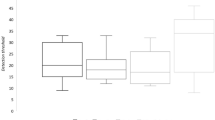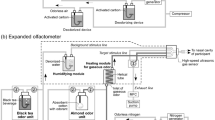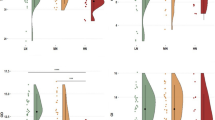Abstract
Background:
Exposure to palatable food odors influences appetite responses, either promoting or inhibiting food intake. Possibly, food odors are appetizing after a short exposure (of circa 1–3 min), but become satiating over time (circa 10–20 min).
Objective:
To investigate the effect of odor exposure on general appetite and sensory-specific appetite (SSA) over time.
Design:
In a cross-over study, 21 unrestrained women (age: 18–45 years; BMI: 18.5–25 kg m−2) were exposed for 20 min to eight different odor types: five food odors, two nonfood odors and no-odor. All odors were distributed in a test room at suprathreshold levels. General appetite, SSA and salivation were measured over time.
Results:
All food odors significantly increased general appetite and SSA, compared with the no-odor condition. The nonfood odors decreased general appetite. All effects did not change over time during odor exposure. Savory odors increased the appetite for savory foods, but decreased appetite for sweet foods, and vice versa after exposure to sweet odors. Neither food odors nor nonfood odors affected salivation.
Conclusions:
Palatable food odors were appetizing during and after odor exposure and did not become satiating over a 20-min period. Food odors had a large impact on SSA and a small impact on general appetite. Moreover, exposure to food odors increased the appetite for congruent foods, but decreased the appetite for incongruent foods. It may be hypothesized that, once the body is prepared for intake of a certain food with a particular macronutrient composition, it is unfavorable to consume foods that are very different from the cued food.
This is a preview of subscription content, access via your institution
Access options
Subscribe to this journal
Receive 12 print issues and online access
$259.00 per year
only $21.58 per issue
Buy this article
- Purchase on Springer Link
- Instant access to full article PDF
Prices may be subject to local taxes which are calculated during checkout





Similar content being viewed by others
References
Harrold JA, Dovey TM, Blundell JE, Halford JCG . CNS regulation of appetite. Neuropharmacology 2012; 63: 3–17.
Woods SC . The eating paradox—How we tolerate food. Psychol Rev 1991; 98: 488–505.
Fedoroff I, Polivy J, Peter Herman C . The specificity of restrained versus unrestrained eaters' responses to food cues: general desire to eat, or craving for the cued food? Appetite 2003; 41: 7–13.
Ferriday D, Brunstrom JM . How does food-cue exposure lead to larger meal sizes? Br J Nutr 2008; 100: 1325–1332.
Cornell CE, Rodin J, Weingarten H . Stimulus-induced eating when satiated. Physiol Behav 1989; 45: 695–704.
Jansen A, Theunissen N, Slechten K, Nederkoorn C, Boon B, Mulkens S et al. Overweight children overeat after exposure to food cues. Eat Behav 2003; 4: 197–209.
Oakes ME, Slotterback CS . Self-reported measures of appetite in relation to verbal cues about many foods. Curr Psychol 2000; 19: 137–142.
Rogers PJ, Hill AJ . Breakdown of dietary restraint following mere exposure to food stimuli: interrelationships between restraint, hunger, salivation, and food intake. Addict Behav 1989; 14: 387–397.
Engelen L, de Wijk RA, Prinz JF, van der Bilt A, Bosman F . The relation between saliva flow after different stimulations and the perception of flavor and texture attributes in custard desserts. Physiol Behav 2003; 78: 165–169.
Ferriday D, Brunstrom JM . ‘I just can’t help myself': effects of food-cue exposure in overweight and lean individuals. Int J Obes 2011; 35: 142–149.
Yeomans MR . Olfactory influences on appetite and satiety in humans. Physiol Behav 2006; 89: 10–14.
Stroebele N, De Castro JM . Effect of ambience on food intake and food choice. Nutrition 2004; 20: 821–838.
Nederkoorn C, Smulders FTY, Jansen A . Cephalic phase responses, craving and food intake in normal subjects. Appetite 2000; 35: 45–55.
Power ML, Schulkin J . Anticipatory physiological regulation in feeding biology: cephalic phase responses. Appetite 2008; 50: 194–206.
Rolls ET, Rolls JH . Olfactory sensory-specific satiety in humans. Physiol Behav 1997; 61: 461–473.
Jansen A, Vandenhout M . On being led into temptation—counterregulation of dieters after smelling a preload. Addict Behav 1991; 16: 247–253.
Hirsch MDG . R. Weight reduction through inhalation of odorants. J Neurol Orthop Med SufI 1995; 16: 28–31.
Smeets AJ, Lejeune MP, Westerterp-Plantenga MS . Effects of oral fat perception by modified sham feeding on energy expenditure, hormones and appetite profile in the postprandial state. Br J Nutr 2009; 101: 1360–1368.
Rolls BJ, Rolls ET, Rowe EA, Sweeney K . Sensory specific satiety in man. Physiol Behav 1981; 27: 137–142.
Nolan LJ, Hetherington MM . The effects of sham feeding-induced sensory specific satiation and food variety on subsequent food intake in humans. Appetite 2009; 52: 720–725.
Smeets A, Westerterp-Plantenga MS . Oral exposure and sensory-specific satiety. Physiol Behav 2006; 89: 281–286.
Brunstrom JM . Associative learning and the control of human dietary behavior. Appetite 2007; 49: 268–271.
Shaffer SE, Tepper BJ . Effects of learned flavor cues on single meal and daily food intake in humans. Physiol Behav 1994; 55: 979–986.
Sclafani A . Post-ingestive positive controls of ingestive behavior. Appetite 2001; 36: 79–83.
Davis JD, Smith GP . The conditioned satiating effect of orosensory stimuli. Physiol Behav 2009; 97: 293–303.
O’Sullivan HL, Alexander E, Ferriday D, Brunstrom JM . Effects of repeated exposure on liking for a reduced-energy-dense food. Am J Clin Nutr 2010; 91: 1584–1589.
Kral TVE . Effects on hunger and satiety, perceived portion size and pleasantness of taste of varying the portion size of foods: a brief review of selected studies. Appetite 2006; 46: 103–105.
Van Strien T . Dutch Eating Behavior Questionnaire Manual (Nederlandse Vragenlijst voor eetgedrag Handleiding). Boom Test Publishers: Amsterdam, 2005.
Distel H, Ayabe-Kanamura S, Martinez-Gomez M, Schicker I, Kobayakawa T, Saito S et al. Perception of everyday odors—Correlation between intensity, familiarity and strength of hedonic judgement. Chem Senses 1999; 24: 191–199.
de Wijk R, Zijlstra S . Differential effects of exposure to ambient vanilla and citrus aromas on mood, arousal and food choice. Flavour 2012; 1: 24.
Blundell J, de Graaf C, Hulshof T, Jebb S, Livingstone B, Lluch A et al. Appetite control: methodological aspects of the evaluation of foods. Obes Rev 2010; 11: 251–270.
Rolls ET, Grabenhorst F, Margot C, da Silva M, Velazco MI . Selective attention to affective value alters how the brain processes olfactory stimuli. J Cogn Neurosci 2008; 20: 1815–1826.
Finlayson G, King N, Blundell JE . Is it possible to dissociate ‘liking’ and ‘wanting’ for foods in humans? A novel experimental procedure. Physiol Behav 2007; 90: 36–42.
Finlayson G, King N, Blundell J . The role of implicit wanting in relation to explicit liking and wanting for food: implications for appetite control. Appetite 2008; 50: 120–127.
Brunstrom JM, Yates HM, Witcomb GL . Dietary restraint and heightened reactivity to food. Physiol Behav 2004; 81: 85–90.
Delamater AR . Partial reinforcement and latent inhibition effects on stimulus-outcome associations in flavor preference conditioning. Learn Behav 2011; 39: 259–270.
Lappalainen R, Sjödén P-O, Karhunen L, Gladh V, Lesinska D . Inhibition of anticipatory salivation and craving in response to food stimuli. Physiol Behav 1994; 56: 393–398.
Hulshof KFAM, Ocke MC, Van Rossum CTM, Buurma-Rethans EJM, Brants HAM, Drijvers JMM et al Results of the Food Consumption Survey Report no.: RIVM report 350030002/2004 Bilthoven, 2003.
WHO. Principles for the Estimation of Energy Requirements. Energy and Protein Requirements. WHO: Geneva, 1985.
Rolls BJ . Sensory-specific satiety. Nutr Rev 1986; 44: 93–101.
Hetherington MM, Boyland E . Short-term effects of chewing gum on snack intake and appetite. Appetite 2007; 48: 397–401.
Hetherington MM, Regan MF, Boyland E . Chewing it over: effects of chewing gum on appetite. Appetite 2008; 50: 560–560.
Hetherington MM, Regan MF . Effects of chewing gum on short-term appetite regulation in moderately restrained eaters. Appetite 2011; 57: 475–482.
Drewnowski A, Grinker JA, Hirsch J . Obesity and flavor perception: multidimensional scaling of soft drinks. Appetite 1982; 3: 361–368.
Negoias S, Visschers R, Boelrijk A, Hummel T . New ways to understand aroma perception. Food Chem 2008; 108: 1247–1254.
Small DM, Gerber JC, Mak YE, Hummel T . Differential neural responses evoked by orthonasal versus retronasal odorant perception in humans. Neuron 2005; 47: 593–605.
Feldman M, Richardson CT . Role of thought, sight, smell, and taste of food in the cephalic phase of gastric acid secretion in humans. Gastroenterology 1986; 90: 428–433.
Larsen JK, Hermans RCJ, Engels RCME . Food intake in response to food-cue exposure. Examining the influence of duration of the cue exposure and trait impulsivity. Appetite 2012; 58: 907–913.
Bender G, Hummel T, Negoias S, Small DM . Separate signals for orthonasal vs. retronasal perception of food but not nonfood odors. Behav Neurosci 2009; 123: 481–489.
Eiler WA II, Dzemidzic M, Case KR, Considine R, Kareken D . Correlation between ventromedial prefrontal cortex activation to food aromas and cue-driven eating. fMRI Study 2012; 5: 27–36.
Berthoud HR, Munzberg H, Richards BK, Morrison CD . Neural and metabolic regulation of macronutrient intake and selection. Proc Nutr Soc 2012; 71: 390–400.
Smeets PAM, Erkner A, de Graaf C . Cephalic phase responses and appetite. Nutr Rev 2010; 68: 643–655.
Mattes RD . Nutritional implications of the cephalic-phase salivary response. Appetite 2000; 34: 177–183.
Rolls BJ, Rowe EA, Rolls ET, Kingston B, Megson A, Gunary R . Variety in a meal enhances food-intake in man. Physiol Behav 1981; 26: 215–221.
Rolls BJ, Duijvenvoorde PMV, Rolls ET . Pleasantness changes and food intake in a varied four-course meal. Appetite 1984; 5: 337–348.
Rolls BJ, Rowe EA, Rolls ET . How sensory properties of foods affect human feeding behavior. Physiol Behav 1982; 29: 409–417.
Trellakis S, Tagay S, Fischer C, Rydleuskaya A, Scherag A, Bruderek K et al. Ghrelin, leptin and adiponectin as possible predictors of the hedonic value of odors. Regul Pept 2011; 167: 112–117.
Acknowledgements
We would like to thank NWO-STW for funding and Givaudan, Allsens, and IFF for providing the odors for this study. Furthermore, we thank Loes van Tiel, Daphne Bosman, Nancy Holthuysen and Xandra Bakker-de Haan, for their help prior to and during the study, Dione Bouchaut for her help with the recruitment of participants, Gerrit Gort for statistical advice and all the participants for their contribution. Finally, we thank Rene de Wijk, Markus Stieger and all members of the STW guidance committee for their advice prior to the study. This work was financially supported by the Dutch Technology Foundation STW (grant 07438) with co-financers: Unilever, CSM, Danone Netherlands, and Royal Friesland Campina. Furthermore, the odors used were provided by Givaudan, Allsens, and IFF.
Author information
Authors and Affiliations
Corresponding author
Ethics declarations
Competing interests
The authors declare no conflict of interest.
Rights and permissions
About this article
Cite this article
Ramaekers, M., Boesveldt, S., Lakemond, C. et al. Odors: appetizing or satiating? Development of appetite during odor exposure over time. Int J Obes 38, 650–656 (2014). https://doi.org/10.1038/ijo.2013.143
Received:
Revised:
Accepted:
Published:
Issue Date:
DOI: https://doi.org/10.1038/ijo.2013.143
Keywords
This article is cited by
-
The Effect of Food Odor Exposure on Appetite and Nutritional Intake of Older Adults with Dementia
The Journal of nutrition, health and aging (2022)
-
Olfactory Capabilities Towards Food and Non-food Odours in Men and Women of Various Weight Statuses
Chemosensory Perception (2022)
-
The importance of the olfactory system in human well-being, through nutrition and social behavior
Cell and Tissue Research (2021)
-
Influence of olfactory dysfunction on the perception of food
European Archives of Oto-Rhino-Laryngology (2019)
-
Two Drosophila Neuropeptide Y-like Neurons Define a Reward Module for Transforming Appetitive Odor Representations to Motivation
Scientific Reports (2018)



